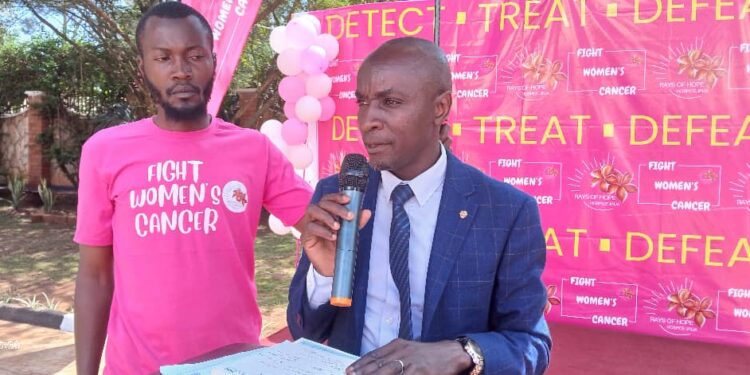Rays of Hope Hospice Jinja, the sole provider of palliative care services in Busoga sub region, has dedicated the month of October 2024 to intensify awareness campaigns on the dangers of cervical cancer.
The organization aims to educate the public on the importance of early detection and treatment of the disease, which affects hundreds of thousands of women in Uganda.
The launch ceremony was presided over by Dr Kibuuka Afizi the Deputy Director/Clinical Head Jinja Regional Referral Hospital (JRRH) who represented his boss, Dr Alfred Yayi.
He made a passionate appeal to women in the Busoga sub-region to prioritize regular medical check-ups, particularly for cancer-related illnesses.
Speaking during the launch of Cancer Month for October at Rays of Hope Jinja Hospice, Dr. Kibuuka pointed out that most patients only seek medical attention when they are already severely ill or caring for ailing loved ones.
“…at JRRH, we have a fully-equipped cancer unit offering diagnostic and treatment services, however, most women visit us when the cancer has advanced, reducing chances of effective treatment…”,he noted.
Dr. Kibuuka stressed that early detection significantly improves survival rates and treatment outcomes.
He encouraged women to take advantage of the hospital’s comprehensive cancer services, including screening, diagnosis, and care.
“…let us change the narrative and fight cancer together, early detection is key, I encourage all women to take charge of their health and visit us for regular check-ups…” he appealed.
Speaking at the same launch ceremony held on Tuesday at the organization’s office along Kiira Road in Jinja City, the Executive Director Ms. Sylvia Nakami emphasized the significance of addressing cervical cancer.
“…cancer affects women and girls who are the mothers of the nation. Once a mother is down, the whole family is affected, and ultimately, the country suffers,” she said.
Ms. Nakami revealed alarming statistics, stating that on average, 1 in 6 women have either precancerous changes or are suspicious of cancer.
She highlighted the organization’s efforts in screening over 11,000 women for cervical cancer since 2018.
“…if found with precancerous changes, the woman can be treated on-site, and if further tests or treatment are needed, we ensure she receives the necessary care…”, Ms Nakami told her guests.
The awareness campaign, themed “Fight Against Women’s Cancer,” will feature community outreaches by clinical officers and counselors, radio talk shows, press releases, and a Cancer Run on October 26, 2024, at the Jinja Golf Club grounds.
Proceeds from the ride-walk-run will go towards supporting the patients, most who have resigned to wait for death because of their vulnerability without meaningful5 sources of income.
Ms. Nakami urged the community to take action, noting that most women report to their facility when the disease is already in its advanced stage, making intervention challenging.
Challenges Facing Women.
Ms Irene Maleba and Joan Mbabazi (palliative care clinical officers) urged stakeholders, community members, and journalists to join forces in combating cervical cancer and promoting women’s health in Busoga Region.
The duo gave detailed statistics saying cervical cancer is the most common cause of new cancers in Uganda representing 20.5%.
Quoting the Cervical and Breast Cancer in Uganda (2020) report, they say the second most common cancer in Uganda is breast cancer.
What You Need To Know:
Cervical cancer originates in the cervix, the lower part of the uterus. It’s primarily caused by the Human Papillomavirus (HPV), which is preventable through vaccination.
Signs and Symptoms.
Early stages may be asymptomatic. As cancer progresses, common signs and symptoms include: abnormal vaginal bleeding (for example, after intercourse, between menstrual periods, or postmenopausal), pelvic pain or discomfort, unusual vaginal discharge, heavy or prolonged menstrual periods and pain during intercourse.
Breast Cancer
Breast cancer develops in breast tissue, affecting women and men, although women are more likely to be affected.
Common signs and symptoms include: lump or thickening in breast or underarm area, change in breast size or shape, dimpling or puckering of breast skin, redness or scaliness of breast skin, nipple discharge or change in nipple position and pain or tenderness in breast.
Why Women Report Late for Treatment and Care?
Despite advancements in detection and treatment, many women still report late for cervical and breast cancer care due to a number of factors.
These include lack of awareness because of limited knowledge about risks, symptoms and screening options, cultural and social barriers including stigma, modesty or gender-related issues, financial constraints, distance or inadequate facilities.
Some women also prioritize family responsibilities over personal health while others have unfounded anxiety about diagnosis and treatment, especially chemotherapy.
Ms Sylvia Nakami has urged the media in the region to support Rays of Hope Hospice Jinja to address the challenges through education and awareness campaigns
Early detection significantly improves survival rates for both cervical and breast cancers.
Encouraging women to prioritize their health and seek timely medical attention is crucial.
Do you have a story in your community or an opinion to share with us: Email us at editorial@watchdoguganda.com













